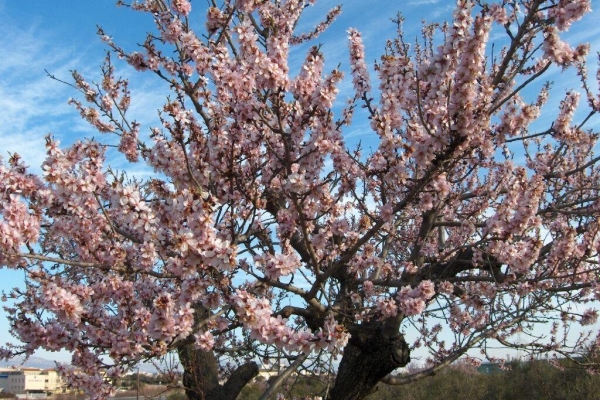Almond is a tall tree or shrubwhich belongs to the genus Drain and the Pink family. Many believe that almond is a nut, but in fact it is not, it is a stone fruit.
Table of contents
Description and flowering ornamental shrubs
Almond tree reaches a height of 4-6 meters, and a bush 2-3 meters. The rhizome consists of 3-5 skeletal roots that are able to penetrate deep into the ground, thereby protecting themselves from drying out.
The plant is quite branchy, while it consists of two types of shoots, which include shortened generative and elongated vegetative.
Dark green leaves mounted on brown petioles and have a lanceolate form with a pointed tip.
Flowers Such plants consist of 5 petals painted white or light pink. On average, the diameter of a single flower is 2.5 centimeters.
Almond fruit - this is a drupe, dry and velvety to the touch, with a leathery and fleshy green pericarp.
After drying, the flesh is very easily separated from the edible oval bone and long, equal to 2.5 - 4 centimeters. It is characterized by a large number of furrows.
The first fruiting occurs at 4-5 year of tree life, but in full force it appears only for 10-12 years. With good care, the shrub bears fruit for 30-50 years.
In addition to receiving fruits Almonds are also grown for ornamental purposes.. Pink or white foam of flowers of such a tree not only decorate the garden in early spring, but also exude a unique scent.
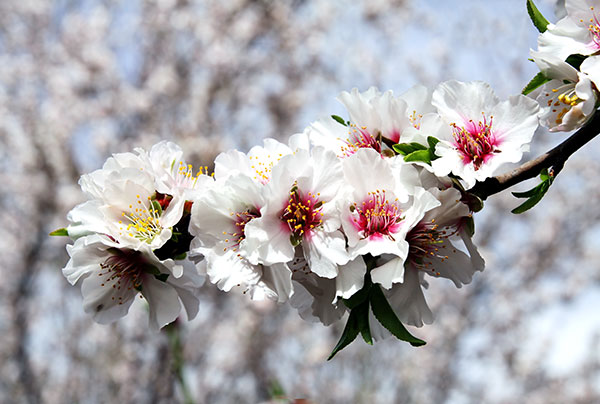
Almond is a plant whose pollination needs to be taken care of in advance. There are two types of trees:
- first need cross pollination, therefore, at least 3 pollinators are planted next to the fruiting almonds, the flowering time of which must be the same;
- the latter are pollinated by beestherefore, it is desirable that 2-3 hives stand next to the plant.
Initially, it was thought that it was possible to grow almonds only in the southern regions, but with the development of scientific technology, breeders have bred varieties that, with proper shelter, can survive even the most severe winter.
Sorta
Sweet almond varieties are grown in culture, the following species are especially popular:
- Anniversary - the variety blooms rather late, has good drought resistance. The skin is of medium thickness, and the core is sweet, dense and dry;
- Ayudagsky - this variety is late-ripening and skoroplodny, the first fruiting comes already at 3 year of the tree's life. Fruits covered with soft shells are a dense, slightly flattened oval core of light brown color;
- Sevastopol - this almond boasts excellent resistance to heat and drought,besides, he brings a huge amount of harvest. The fruit shell is soft, and the kernels themselves are dense, sweet, painted in white weave;
- Mangul - this late ripening variety is not afraid of drought. Solid and dense kernels with increased lubricity covered with a soft shell. A distinctive feature is good immunity to most diseases and pests;
- Dessert - this self-infertile almond is well suited for growing in central Russia, because it is not afraid of recurrent frosts and frostbite of flower buds. The shell is soft and rough. The oval-shaped kernels are very sweet and oily. As a pollinator for this variety are usually used almond seaside or spicy.
Rules for planting an almond tree in open ground
It is best to grow almonds from annual seedlingswhich are placed in open ground in early March or at the end of November.
As a place to plant a plant choose a sunny, draft-free area and gusting winds, also almonds can grow well in partial shade.
Before planting the plant, it is necessary to prepare the pit. In the autumn, two weeks before planting, they dig out pits, the diameter and depth of which will be 50-70 centimeters.
If almonds are planted in groups, then the distance between individual trees should be 3-4 meters, and between rows of 5-6 meters.
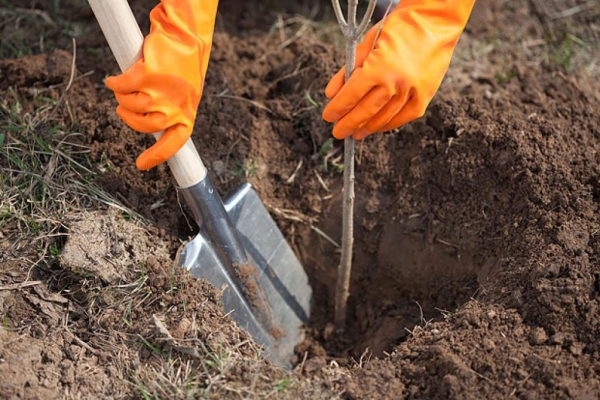
A drainage layer is laid on the bottom of each pit.consisting of rubble or gravel. Then they are placed fertile soil consisting of the following elements:
- 1 part of sand;
- 2 parts of humus;
- 3 pieces of leafy ground;
- 5-6 kilograms of rotted manure or humus;
- 500 grams of superphosphate;
- in the presence of acidic soil, 200-300 grams of dolomite flour or lime are additionally added to it.
After the pit is infused enough you can start planting a tree:
- initially in the center of the pit they drop in a support with a height of 1-1.5 meters;
- then around it build a hill of the earth;
- the seedling is placed on the knoll so that the root neck is 3-5 centimeters higher than the ground;
- in the next stage, the pit is filled with fertile soil, tamped and watered thoroughly;
- Once the water is fully absorbed, the seedling is tied to a support and mulch the soil with a 3-5 cm layer of peat or dry leaves.
During the spring planting, the pit is also prepared in the autumn.
How to plant almonds:
Almond care
Almond care consists of several standard procedures that must be performed when growing almost all fruit trees.
For the best fruiting Almond needs regular watering.. Young plants are watered every 2 weeks, and adults 1 time in 20-25 days.
Loosening the wheel circle beneficial effect on tree growth. The first time such work is carried out at the end of March to a depth of 10-12 centimeters.
Then, during the whole vegetation period, another 3-4 loosening is carried out, but already to a depth of 6-8 centimeters. It is also necessary to timely remove weeds.
In the autumn, the following mixture is added to the near-trunk circle for digging.:
- 1 kilogram of manure;
- 20 grams of potassium sulphide;
- 40 grams of superphosphate.
The first 5-7 years of the life of trees in between rows is recommended to grow green manure.
In Siberia, without shelter, you can grow almond, steppe, low or Russian almonds. In the central zone three-lobed almonds grow well.
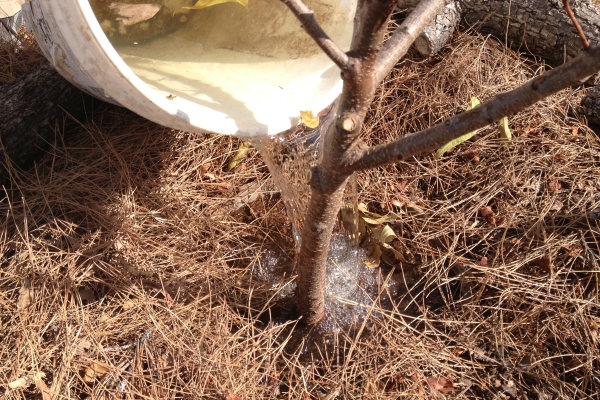
Pruning
In early spring, before bud break it is necessary to remove all frozen, broken, diseased or deforming branches.
After flowering, you can proceed to formative pruning., during which deduce 3 tiers of skeletal branches:
- in the first year, they choose three branches, located 15-20 centimeters from each other and shorten them to a length equal to 15 centimeters;
- the next 2-3 years on the central conductor form 3 tiers, located at a distance of 20-30 centimeters;
- shoots that are insignificant for crown formation are clamped several times over the summer
- the rest is cut to 50-60 centimeters;
- at the end of the work, the center conductor is shortened so that the distance between it and the upper tier is 55-60 centimeters.
In the autumn, after the leaves fall off, they carry out sanitary and anti-aging pruning.That is, they remove all the dry, diseased, broken, growing in the wrong direction and thickening branches of the crown.
It is worth remembering that when pruning thick branches, the cut place must be treated with garden pitch.

Diseases and pests
The most common on almonds are the following types of diseases:
- Cercosporosis - initially on the leaves appear brown spots with a diameter of 2-4 millimeters, on which you can see a gray patina. Then the center of the leaf dries and falls.
- Scab - This is a fungal disease that affects the leaves, flowers and shoots of a tree.
- Rust - red spots appear on the upper side of the leaf, and brown pads on the inner side. Over time, the leaves dry and fall off.
- Perforated spotting - The disease affects all parts of the tree. You can find it on the leaves, because they appear characteristic spots of red shades with a dark border at the edges.
- Gray rot - on the shoots appear brown spots and gray fluffy bloom.
Among the pests on the almond you can find insects such as seed eater, aphid, moth or spider mite.
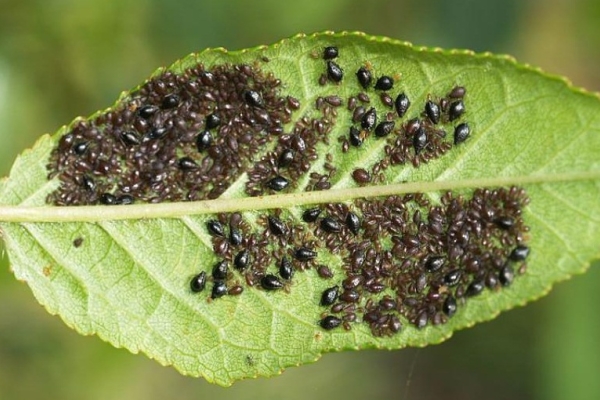
As a pest control, trees must be treated with insecticides, which include Aktellik, Fufanon, Tagore.
Against aphids use Biotlin or Antitlin. To get rid of spider mites, you can use drugs Apollo, Agravertin or Fitoverm.
As you know, it is much better to prevent the appearance of any trouble than to treat it, therefore Preventive measures will be extremely effective:
- in early spring, before the formation of buds, the tree and the soil around it are treated with 1% Brodsky solution;
- after the end of leaf fall processing should be repeated;
- the best preventive measure will be compliance with agricultural cultivation. This includes proper watering, weed removal and sanitary pruning.
Remove almonds only after the green outer shell turns dark and becomes easily separated from the core.
The use of flowering trees in landscape design
Almond has a very beautiful and unusual flowering., for which it is often planted for decorative purposes. Early flowers can only decorate a waking garden and create a spring mood.
Almond tree is an amazing flowering plant., which in modern conditions can be grown anywhere in the country. With proper implementation of all recommendations, you can get very tasty bone fruit.
